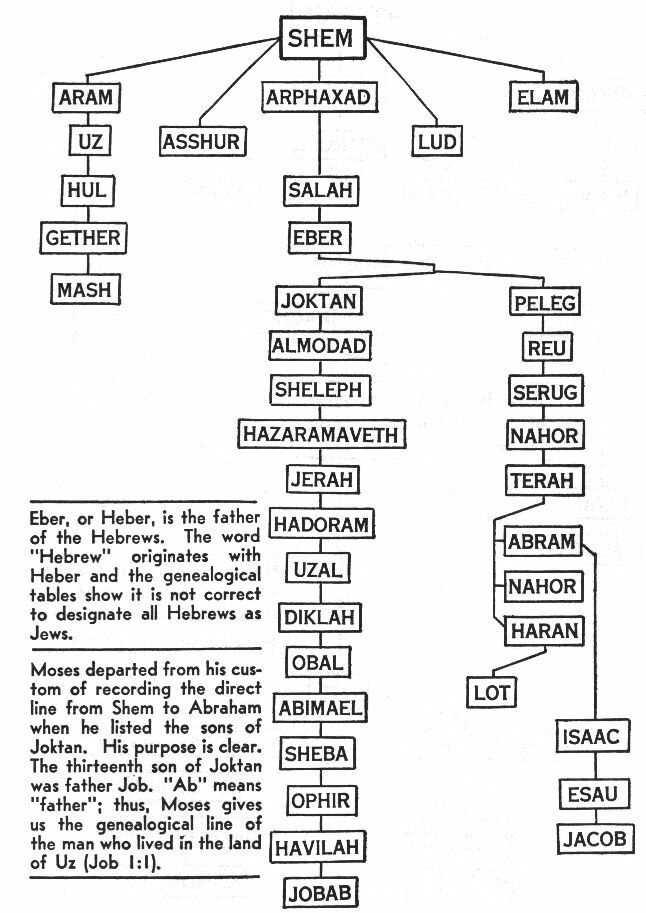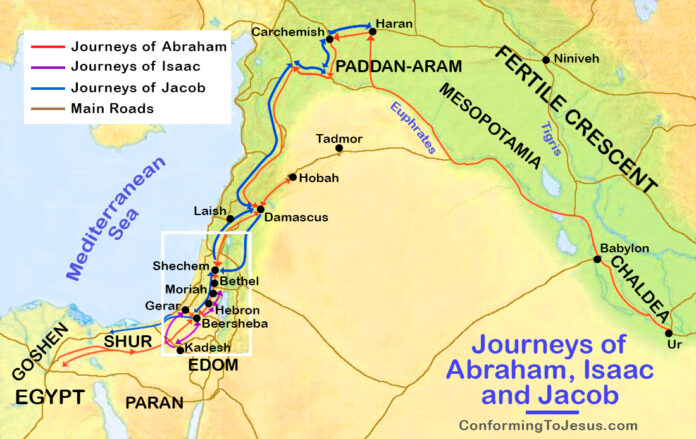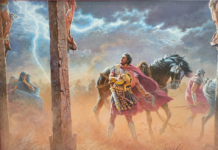The title of this blog is, Did Abraham Receive the Birthright? The quick and simple possible answer is, “Abraham never did receive the birthright, though he was in line to receive it. Hence, it passed directly from Shem to Isaac.” Dr. Stephen E. Jones.
Although Dr. Jones shares his opinion, I feel it is very possible it contains much truth. However, nothing is more true than studying the KJV Bible and Book of Mormon with the Spirit of God. My and opinions in this blog do not represent the belief of The FIRM Foundation nor The Church of Jesus Christ of Latter-day Saints. This information is given as a personal opinion and it is up to you to discern truth with your own personal revelation.
To me the idea about the birthright is a very interesting finding of Dr. Jones. I had never even thought about whether Abraham had the birthright, as I always assumed he did. Knowing that Shem outlived Abraham makes this a very possible scenario.
 The title of this blog could also be, was Shem and Melchizedek the same person?
The title of this blog could also be, was Shem and Melchizedek the same person?
I had always wondered about whether Shem and Melchizedek was the same person? I wrote a blog in 2019 where I said, “I haven’t decided myself the answer to this question, but it is an interesting discussion about significant leaders of the ancient church. It seems to me it is more likely they are the same person, but I would like some discussion about your opinion.” Since reading Dr. Jones’ book called, “The Struggle for the Birthright” by Stephen E. Jones, I have come up with a very favorable answer of I feel it makes sense that Shem and Melchizedek are the same person. You will also see the importance of the book of Jasher. Read below for your own answers.
LDS Dictionary
“Shem was the traditional ancestor of the Shemitic or Semitic races, a group of kindred nations, which includes the Arabs, the Hebrews and Phoenicians, the Arameans or Syrians, the Babylonians and Assyrians. The languages spoken by these various nations were closely related and were known as the Semitic languages. In latter-day revelation Shem is referred to as “the great high priest” LDS Bible Dictionary “Shem”

Shem was Melchizedek by Stephen E. Jones
To show that Shem was the Melchizedek of Gen. 14:18, we will quote from Jasher 16:11, 12, which tells us the story of Abram’s meeting with Melchizedek after freeing Lot :“And Adonizedek king of Jerusalem, the same was Shem, went out with his men to meet Abram and his people, with bread and wine, and they remained together in the valley of Melech. And Adonizedek blessed Abram, and Abram gave him a tenth from all that he had brought from the spoil of his enemies, for Adonizedek was a priest before God.”

Many people have misunderstood Melchizedek, thinking him to be Jesus Christ incarnate. Their belief is based upon a misreading of Heb. 7:1-8. Verse 3 says Melchisedec was: “without father, without mother, without genealogy, having neither beginning of days nor end of life; but made like the Son of God.” (NASB)
This must be taken in the context of verse 6. Heb. 7:6 says in the KJV, ” But he whose descent is not counted from them received tithes of Abraham.” The NASB reads, ” But the one whose genealogy is not traced from them collected a tenth from Abraham.” In other words, Melchisedec’s genealogy is not counted, traced, or RECORDED by the biblical writer, and in this way is he also a type of Christ. It does NOT say that Melchisedec literally had no parents. It only says that he merely appears out of nowhere in the biblical text, with no explanation of who he was or who were his parents. This divine silence in the biblical text was done purposefully in order to make him a type of Christ, that is, ” one like the Son of God.”
Shem himself lived to the ripe old age of 600 years. He was a century old when the flood came, and lived 500 years after the flood. If one charts the genealogies of Gen. 11, as we did on page 17 of Secrets of Time, we find that Shem outlived Abraham. In fact, Shem died when Isaac was 50 years old.
Jewish traditions teach that Shem built Jerusalem, and he would therefore be its king. He was still alive during all of Abraham’s life. Therefore, it would only stand to reason that Abraham would pay tithes to him, for he was the true king of all the earth and was the birthright holder. In fact, because Shem outlived Abraham, Abraham never did receive the birthright, though he was in line to receive it. Hence, it passed directly from Shem to Isaac, and this is why the biblical narrative does not tell us about the birthright until Isaac’s sons fought over it.” The Struggle for the Birthright” Chapter 2; Shem was Melchizedek by Dr. Stephen E. Jones.
![]()

Below are other articles that validate this opinion of mine. I think it is significant to understand the importance of Melchizedek, as he was and is a representative of Christ. Just think about the name of the Priesthood today.
As The Church of Jesus Christ of Latter-day Saints said, “Before his day it was called the Holy Priesthood, after the Order of the Son of God. But out of respect or reverence to the name of the Supreme Being, to avoid the too frequent repetition of his name, they, the church, in ancient days, called that priesthood after Melchizedek, or the Melchizedek Priesthood.” Source
Is it possible that Shem and Melchizedek are the same person?
By Alma E. Gygi

This question is frequently asked and is an interesting one. Let us examine first what we know about Shem. Although the Bible names Shem as the eldest son of Noah (Gen. 5:32), modern-day revelation places Japheth as the eldest (Moses 8:12). Both reports, however, are harmonious in naming Shem as the progenitor of Israel and in the fact that the priesthood descended through Shem to all the great patriarchs after Noah. (1 Chr. 1:24–27.) In this patriarchal order of priesthood, Shem stands next to Noah. He held the keys to the priesthood and was the great high priest of his day. 1
Living contemporary with Shem was a man known as Melchizedek, who was also known as the great high priest. 2 The scriptures give us the details of Shem’s birth and ancestry but are silent as to his ministry and later life. Of Melchizedek, however, the opposite is true. Nothing is recorded about his birth or ancestry, even though the Book of Mormon states that he did have a father. (Alma 13:17–18.) Concerning his ministry and life we have several interesting and important facts. (Gen. 14:18–20; Heb. 7:1–4; Alma 13:17–18.)
All of this provokes some questions and calls for answers. Were there two high priests presiding at the same time? Why is the record silent concerning Shem’s ministry? Why is nothing known concerning Melchizedek’s ancestry?
Because of this state of knowledge on our part, many Saints and gospel scholars have wondered if these men were the same person. The truth is, we do not know the answer. But an examination of the scriptures is fascinating, because it seems to indicate that these men may have been one and the same. For example, here is the case for their oneness:
- The inheritance given to Shem included the land of Salem. Melchizedek appears in scripture as the king of Salem, who reigns over this area.
- Shem, according to later revelation, reigned in righteousness and the priesthood came through him. Melchizedek appears on the scene with a title that means “king of righteousness.”
- Shem was the great high priest of his day. Abraham honored the high priest Melchizedek by seeking a blessing at his hands and paying him tithes.
- Abraham stands next to Shem in the patriarchal order of the priesthood and would surely have received the priesthood from Shem; but D&C 84:5–17says Abraham received the priesthood from Melchizedek.
- Jewish tradition identifies Shem as Melchizedek.3
- President Joseph F. Smith’s remarkable vision names Shem among the great patriarchs, but no mention is made of Melchizedek.
- Times and Seasons (vol. 6, p. 746) speaks of “Shem, who was Melchizedek. …”
On the other hand, there is a case for their being two distinct personalities. Many persons believe D&C 84:14 is proof that there are perhaps several generations between Melchizedek and Noah. The scripture says, “Which Abraham received the priesthood from Melchizedek, who received it through the lineage of his fathers, even till Noah.”
If it does turn out that Shem and Melchizedek are the same person, this scripture should prove no stumbling block, because it could be interpreted to mean that priesthood authority commenced with Adam and came through the fathers, even till Noah, and then to Shem.
I Have a Question answered by Alma E. Gygi, Salt Lake City businessman.
Notes
- Joseph F. Smith, Gospel Doctrine (Deseret Book Co., 1919) p. 474.
- When Abraham returned from the war, Shem, or, as he is sometimes called, Melchizedek, the king of righteousness, priest of the Most High God. …” (Ginsberg, Legends of the Jews, p. 233.) “Jewish tradition pronounces Melchizedek to be a survivor of the Deluge, the patriarch Shem.” (Smith’s Bible Dictionary, p. 393.) “And Adonizedek king of Jerusalem, the same was Shem. …” (Book of Jasher 16:11.)
The Connection between Melchizedek and Shem by Tim Barker

“…According to Jewish traditions, Melchizedek is Shem, the son of Noah, whom God consecrated to be a priest for ever, and who set up a kingdom on Salem.”(1) Included in his book on the Legends of Old Testament Characters, the Reverend Sabing Baring-Gould includes a quotation from the Targumim, stating, “Melchizedek, who was Shem, son of Noah, king of Jerusalem.” (2) Louis Ginzberg continues this tradition, in his Legends of the Bible (a condensed version of the 7-volume Legends of the Jews), stating that “when Abraham returned from the war, Shem, or, as he is sometimes called, Melchizedek, the king of righteousness, priest of God Most High, and king of Jerusalem, came forth to meet him with bread and wine.” (3) More recently, scholars Raphael Patai and Robert Graves note that, “others again say that Melchizedek (also known as Adoni-Zedek), was Abram’s ancestor Shem, and that he now taught Abram the duties of priesthood…” (4) Numerous other historical Jewish sources confirm this same teaching.
In 1842, Elder John Taylor, then editor of the Times and Seasons, published the following:
From this definite account of driving the “nations apart, when the ancient hills did bow,” all reflecting minds may judge that man was scattered over the whole face of the earth. And with the superior knowledge of men like Noah, Shem (who was Melchizedek) and Abraham, the father of the faithful, three contemporaries, holding the keys of the highest order of the priesthood… (5)

Other Latter-day Apostles have discussed this issue as well. Elder John A. Witdsoe stated: There is an old Hebrew tradition that Melchizedek was none other than Shem, the son of Noah. As far as the age of Shem is concerned, that is possible. Shem lived five hundred two years after the flood, and Abraham was born two hundred ninety-two years after the flood. Abraham, therefore, must have known Shem. (6)
Prepare for 2023 Gospel Doctrine with our Newly Released, Annotated Edition of the New Testament.
Tim Barker continues, “Additionally, Elder Alvin R. Dyer stated: Abraham, who was born of the chosen lineage of patriarchs, received the priesthood from Shem, or Melchizedek, who received it from Noah unto whom it had come through the lineage of the fathers from Enoch, unto whom it had come from Adam the first man through his son, Abel. (7)
More recently and readily available, is the CES Institute Manual on the first half of the Old Testament. This manual outlines, amongst other things, 7 points for consideration relating to the identity of Shem and Melchizedek and commonalities between the two. The comments on this issue are based on an Ensign article, by Alma E. Gygi, entitled, “Is it possible that Shem and Melchizedek are the same person?” (8)
Shem’s inheritance included the land of Salem, and Melchizedek was the king of Salem.
Shem “reigned in righteousness” and Melchizedek’s name means “king of righteousness.”
Shem was the great high priest of his day. Abraham honored the high priest Melchizedek by paying him tithes and seeking blessings at his hand.
Abraham stands next to Shem in the patriarchal order of the priesthood and would likely have received the priesthood from him, but according to D&C 84:5-7, Abraham received the priesthood from Melchizedek.
Jewish tradition identifies Shem as Melchizedek
President Joseph F. Smith’s vision of the Redemption of the Dead (D&C 138), names Shem among the great patriarchs, but there is no mention of Melchizedek.
Times and Seasons (official church periodical at this time), indicates that Shem was Melchizedek. (9)
On the contrary, some Latter-day Saints, including Apostle Bruce R. McConkie, believes that the two are definitely separate individuals: There is an unsupported tradition to the effect that Melchizedek was the same person as Shem the son of Noah. That this could hardly have been the case is seen from the revelation which says: “Abraham received the priesthood from Melchizedek, who received it through the lineage of his fathers, even till Noah.” (D. & C. 84:14.) In other words, there seem to have been at least two generations between Melchizedek and Shem.(10)
Also for consideration, E. Douglas Clark commented on the matter in his book, The Blessings of Abraham: Becoming a Zion People: Genesis 11:10-11 tells Shem’s life span in the same manner as it tells the life spans of the subsequent patriarchs, implying that Shem died (a passage left unchanged in the Joseph Smith Translation), while the JST Genesis 14 tells that Melchizedek was translated. Second, a latter-day revelation in Doctrine and Covenants 84:14 states that “Abraham received the [Melchizedek] Priesthood from Melchizedek, who received it through the lineage of his fathers, even till Noah, and from Noah till Enoch,” which seems to require at least two generations between Melchizedek and Noah. And third, in Joseph F. Smith’s vision of the redemption of the dead, he saw among the host of righteous post-mortal spirits Shem (D&C 138:41), who would not have been there had he been translated. The revelation does not mention seeing Elijah or Enoch or Moses, who, like Melchizedek, had been translated. (11)
It is clear that with the diversity of opinion on the matter, that no definitive revelation has yet been received. As such, the scriptures are sought for further understanding, and where helpful, supplemental sources provide unique insights.
The Catholic Encyclopedia seems to indicate that the connection was developed by the Rabbi’s to suit their own purposes:
The Rabbins [Rabbi’s] identified Melchisedech with Sem, son of Noe, rather for polemic than historic reasons, since they wished to set themselves against what is said of him as a type of Christ “without father, without mother, without genealogy” (He., vii, 3).
In the Epistle to the Hebrews the typical character of Melchisedech and its Messianic import are fully explained. Christ is “a priest forever according to the order of Melchisedech” (Heb,. vii, 6; Ps., cix, 4); “a high priest forever”, etc. (Heb., vi, 20), …i.e. order or manner (Gesenius), not after the manner of Aaron. The Apostle develops his teaching in Heb., vii: Melchisedech was a type by reason (a) of his twofold dignity as priest and king, (b) by reason of his name, “king of justice”, (c) by reason of the city over which he ruled, “King of Salem, that is, king of peace” (v.2), and also (d) because he “without father, without mother, without genealogy, having neither beginning of days nor end of life, but likened unto the Son of God, continueth a priest forever” (v.3). The silence of Scripture about the facts of Melchisedech’s birth and death was a part of the divine plan to make him prefigure more strikingly the mysteries of Christ’s generation, the eternity of His priesthood.” (12)
Interestingly, an early Jewish source, Flavius Josephus is completely silent regarding any connection between Shem and Melchizedek.
James L. Kugel indicates that “some scholars have suggested that this was first done in the context of later Jewish-Christian polemics: if Melchizedek was actually Shem, then he was the ancestor of Abraham, Isaac, and Jacob, and the idea of a priesthood extending back through him was less disturbing to Jews than the notion of a “priest of God Most High” who lacked any connection to the Jewish people or the later levitical priesthood.” He goes on to say that:
It seems likely, however, that Melchizedek’s identification with Shem actually came about before any Christian arguments existed (and certainly before the time when Christian arguments seemed to Jews to require refutation). After all, who was Melchizedek to early interpreters? Why was the genealogy of such an important person–the “priest of God Most High,” no less–not mentioned? Identifying him as Shem, whose genealogy was known, provided an answer, and an easily accepted one. (13)
It is interesting to note that Kugel alludes to the idea that Melchizedek, “could be understood as an honorific title given to Shem…” (14)
Whatever the connection is, it remains a mystery. As stated by Alma Gygi, “all of this provokes some questions and calls for answers. Were there two high priests presiding at the same time? Why is the record silent concerning Shem’s ministry? Why is nothing known concerning Melchizedek’s ancestry? Because of this state of knowledge on our part, many Saints and gospel scholars have wondered if these men were the same person. The truth is, we do not know the answer.” (15) When the answer comes, it should satisfy the arguments on either side of the matter.
_______________________________________
1 Rev. S. Baring-Gould, Legends of Old Testament Characters, From the Talmud and Other Sources (New York: MacMillan and Co., 1871), 2:1; see also Rev. S. Baring-Gould, Legends of the Patriarchs and Prophets, and Other Old Testament Characters From Various Sources (New York: James B. Millar & Co., 1884), 140-141
2 Baring-Gould, Legends of Old Testament Characters, 2:1
3 Louis Ginzberg, Legends of the Bible (Philadelphia: The Jewish Publication Society of America, 1956), 106
4 Robert Graves and Raphael Patai, Hebrew Myths: The Book of Genesis (New York: McGraw-Hill, 1966), 147
5 John Taylor, “Ancient Ruins,” Times and Seasons 5/23 (Dec 15, 1844):746
6 John A. Widtsoe, Evidences and Reconciliations, 3 Vols., ed. G. Homer Durham (Salt Lake City: Bookcraft, 1960), 232
7 Alvin R. Dyer, Who Am I? (Salt Lake City: Deseret Book, 1968), 400; also see Alvin R. Dyer, The Lord Speaketh (Salt Lake City: Deseret Book, 1964), 284-291
8 Alma E. Gygi, “Is it possible that Shem and Melchizedek are the same person?,” Ensign (November 1973), 15-16
9 Old Testament Student Manual: Genesis-2 Samuel (Religion 301), Church Educational System (Salt Lake City: The Church of Jesus Christ of Latter-day Saints, 2003), 67-68
10 Bruce R. McConkie Mormon Doctrine, 2nd Ed. (Salt Lake City: Bookcraft, 1966), 475
11 E. Douglas Clark, The Blessings of Abraham: Becoming A Zion People (American Fork, UT: Covenant Communications, 2005), 267 fn 36
12 John J. Tierney, “Melchisedech” The Catholic Encyclopedia, 15 Vols., eds. Charles G. Herbermann, et al (New York: The Encyclopedia Press, 1913), 10:157
13 James L. Kugel, Traditions of the Bible: A Guide to the Bible as it was at the Start of the Common Era (Cambridge, MA: Harvard University Press, 1999), 289-290
14 Ibid, 290
15 Old Testament Student Manual: Genesis-2 Samuel, 68
LDS Bible Dictionary

The LDS Bible dictionary says, under the heading Shem says, Name. Son of Noah (Gen. 5:29–32; 6:10; 7:13; 8:16; 9:26; Moses 8:12); his descendants (Gen. 10:21–31; 11:10–32; 1 Chr. 1:17; Luke 3:36). Shem was the traditional ancestor of the Shemitic or Semitic races, a group of kindred nations, which includes the Arabs, the Hebrews and Phoenicians, the Arameans or Syrians, the Babylonians and Assyrians. The languages spoken by these various nations were closely related and were known as the Semitic languages. In latter-day revelation Shem is referred to as “the great high priest” (D&C 138:41). See also Melchizedek.
The LDS Bible dictionary says, under the heading Melchizedek, “King of Righteousness. A notable prophet and leader who lived about 2000 B.C. He is called the king of Salem (Jerusalem), king of peace, and “priest of the most High God.” Unfortunately, information concerning him in the Bible is relatively scarce, being limited to Gen. 14:18–20; Heb. 5:6; 7:1–3. Mention of the priesthood of Melchizedek is given in several other instances, primarily in Psalms and in Hebrews. However, latter-day revelation gives us much more about him and his priesthood (see JST Gen. 14:17 [Gen. 14:18 note d]; JST Gen. 14:25–40; JST Heb. 7:3 [Appendix]; Alma 13:14–19; D&C 84:14; 107:1–4). From these sources we realize something of the greatness of this prophet and the grandeur of his ministry. See also Jebus; Jerusalem; Melchizedek Priesthood.





